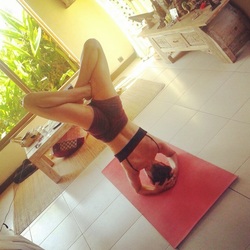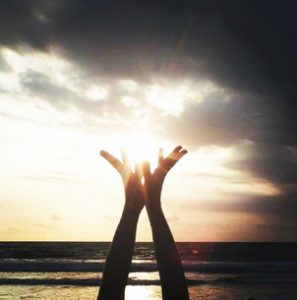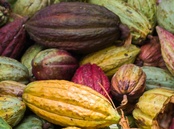The science of Mudras is a big part of yoga and is based on the fundamental principles of life and the five elements of Fire, Air, Ether, Earth and Water corresponding with each finger of the hand.
They are mainly performed as gestures by fingers, hand positions combined with yoga postures or are performed on their own. They are also often done during meditation.
Mudras also known as energy controls hold electromagnetic power which is said once held maintains equilibrium in the body elements.
There are even prescriptions of holding particular mudras for set periods of time for rejuvenating the body, healing diseases and to also help with focus. A mudra for any ailment!
The Yoga Synergy sequences incorporate them within their system and is a great opportunity to experience their effects whilst practicing yoga.
For the purpose of these next few posts we will keep the focus on particular hand mudras and later expand into generating mudras within postures.

PANKAJ MUDRA or also known as the Lotus Mudra
Is a symbol of purity and offering, and a part of worship.
In this mudra both the thumbs and little fingers touch each other.
This mudra is said to develop the fire and water elements as well as balancing them out.
‘Like a lotus, which remains detached from the mud in which it blooms, a practitioner remains detached from the mud of attachment, while continuing their meditation.’
This mudra has a cooling effect on the body, the nervous system improves and the mind becomes calms. It’s said to be a great pacifier for fevers and to work well with blood disorders.
For me I feel like my whole mood lightens up when I make this gesture it makes me want to smile. Try it out for yourself and leave a comment below!
 Many people ask us before we run retreats whether there will be coffee.
Many people ask us before we run retreats whether there will be coffee.
A part of our retreat process is to help you question these types of assumptions that can lead to feelings of guilt or shame. We are about happiness after all!
It does not mean we are hedonists promoting everything that feels good. We just try to help you towards a healthier line of thinking so you can make more informed decisions for yourself, that’s all.
And managing people’s coffee expectations at our yoga and raw food retreat is not hard! We drink coffee! And, we also want to be flexible enough to try different things too.
Below are our quick thoughts on coffee. You will see that some of us have much more knowledge than others and, perhaps most importantly, that we try not to just drink coffee simply out of habit and have had a little think about what we are doing to get to the places we are now—different places as they are!
I had a big break from coffee a couple years back when I started being 100 percent raw. My body just couldn’t tolerate it so I stopped.
When on raw food I was getting naturally stimulated therefore coffee’s stimulating properties were almost too much to handle.
Now, since being on an 80 percent raw food intake, I have discovered the coffee bean again. But I always question where it comes from and how has it been processed etc.
I prefer quality to quantity.
I love it black but sometimes crave the odd nut milk latte.
Oksana
I love the smell of the coffee. And I certainly have a taste for good coffee. I like trying different brews and filtration systems, at the moment I am into Flores and Toraja coffee (different regions in Indonesia). It’s a darker bean, almost black and had a more rounded earthy chocolate taste to it.
I drink my coffee black. And I generally don’t drink it first thing in the morning.
I am very aware of what its effects are on my body.
Coffee has a bad name for it because it’s addictive, can make you jittery, acidic and ‘over stimulated’. Many people ‘use’ coffee to move their bowels in the morning.
There are 2 types of coffee bean – the Robusta and Arabica bean.
The Robusta coffee is a lower grade bean produced heavily by 3rd world countries for big corporation to produce a cheap high caffeinated bean to flood the market. Starbucks, Gloria Jeans, Nestle etc. If it is Big it is using the robusta bean.
The Arabica bean is the higher grade bean, grows usually at higher altitude, and needs more refined conditions.
The caffeine content is what most people get addicted to. Caffeine effects your nervous system and your adrenals. But the most unfavouable quality of coffee is actually its acidity levels. It takes 12 cups of water to reduce the effect of one cup of coffee in your system! That’s 12 cups of water!!!
The smell and the colour of acidic urine is strong! So watch your pee and make sure you drink lots of water to dilute the effects from your body.
I forced myself to start drinking coffee when I started work to be social! I didn’t like it at first but I soon began to. I only had one cup a day.
Then one day I was not able to have my coffee at the regular time due to some routine change.
I got this massive headache that lasted all day and I did not know what it was.
I later figured out that it was this one cup of coffee that my body became addicted to. I didn’t like the idea of being addicted to something. This was all before my days as a practicing yogi.
So I stopped for a while. However, the ritual of a hot drink at certain times was very calming so I was just having something else like a tea or herbal tea or something.
Over time I somehow felt it was time to have some coffee again and I gradually started drinking it. It actually gave me some sort of physiological lift. I think it is the caffeine and it has an effect on my blood pressure. I have naturally quite low blood pressure, which, if it gets too low can make you feel very weak and unable to do anything. I have not had this scientifically verified or anything! But, what I found was that without changing anything else—exercise, diet (vegetarian, a lot of it raw), that cup of coffee seemed to make a difference.
So now I drink coffee again. I will have to look at the type of coffee now Im more informed. You will see I am the most unrefined of the foodies here but that is where I am at. I use an aeropress.
I remember reading Iyengar’s book, Light on Yoga, and in the beginning section it talks about having a cup of tea or coffee in the morning before your practice. I thought, well, if Iyengar says then there you go!
However, I am always acutely aware that coffee is large source of income for millions of people in developing countries. I know that labour conditions are not always the best for them and I hope that can be improved.
Apparently:
65 years after their last meeting BKS Iyengar and Pattabhi Jois met again, and their topic of conversation was their mutual love for coffee!
 In most Asian countries people sit on the floor for most of their daily tasks. All their meals and socialising as well as their general work is still done mainly on the ground. This means that their hips are open and their spines are able to move independently from their hips, this also requires having great strength in the legs and core to be able to get up and down from such high distances with ease, hence Padmasana is a basic pose for many Asian people.
In most Asian countries people sit on the floor for most of their daily tasks. All their meals and socialising as well as their general work is still done mainly on the ground. This means that their hips are open and their spines are able to move independently from their hips, this also requires having great strength in the legs and core to be able to get up and down from such high distances with ease, hence Padmasana is a basic pose for many Asian people.
All these elements are really important to able to get into a seated lotus position. In the West our chair-culture has prevented us from developing these movements and openings. So when we start to practice yoga, just sitting on the floor is our biggest practice.
Moving the spine in different leg positions allows the softening to happen. The ideal way to get into any pose is to move into it without any assistance. By focusing on active movements we develop the muscle intelligence without having to force any joint into a position that might not be ready. In Padmasana so much care needs to be taken around the knee area, but both the hip and ankle joints can also be compromised if these areas are also too stiff.
Just like we cross our arms easily, our legs should be able to move just as gracefully. One of the easier ways to practice lotus is in a headstand where gravity works in our favour. But to do this, first our headstand needs to be proficient so do take care.
So in your normal practice focus on active movements with the usual standing hip opening poses (forward bends, lunges, trikonasana variations, warrior variations, gadjastan variations) as well as moving actively (no hands) into sitting poses.
Make sure to actively externally rotate the hip that should be externally rotated in those postures. Also make sure to remain active in the pose so as not to not sink into hips. Use principles of activating muscles while in lengthened positions.
We can see how a more natural bodied person, Ramali can come into a pose like Padmasana (lotus) with ease and without hands.
Ramali takes her legs into position in two very smooth movements. This is what we are looking for in our practice.While Sonja can do this first thing in the morning, with no preceding warm ups or movements, as we can see in the video she still has a slight ‘sawing’ action to get there. It’s all a practice.
This article was not written to dishearten. But for us to think about the truth and reality of what our body is able to do of its own accord.
Based on ideas of active movements and trying not to force your body into position we encourage students to try to move their legs into postures using just their legs. This brings much more body awareness ~ play around with it when you are next on the mat!
Happy and safe practicing.
Oksana
Join us on our upcoming retreat
www.yogacafecanberra.blogspot.com


